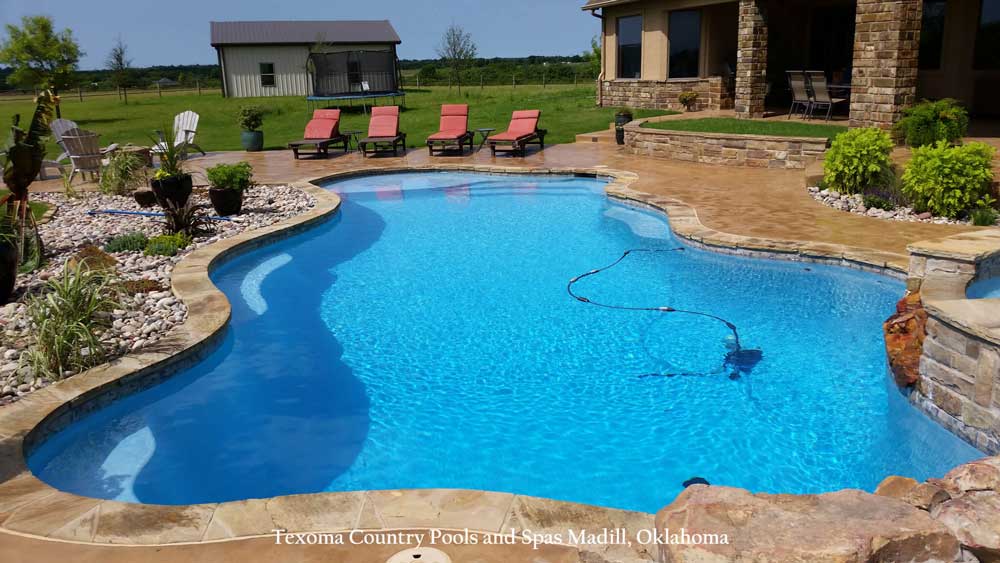Inground Pool
Inground pools are undeniably the thing that separates one home to the next, the easiest way to reinvent your lifestyle, and the sure-bet way to improve your backyard appearance, improve the value of your home, and make your family happier in the process.
But be warned. Your home may become a destination for friends and family.
All of a sudden, people will request parties, get-togethers, and functions be hosted at your home.
Your in-ground pool becomes an extension of you and your home. Check out our inground pool gallery.
Gunite Pools
What is a Gunite pool?
Gunite pools use a rebar framework that is sprayed over with a concrete and sand mixture.
- Gunite Pools are highly resilient and the most flexible style of pool.
- Gunite pools are used in both commercial and residential settings.
We handle both applications. Our design team will collaborate with you or your team in order to develop your custom inground pool.
Gunite pools are not do-it-yourself pool installations. They require licensed electricians, plumbing experts, designers, and an understanding of state & local ordinances.
We are the inground & gunite pool expert. Our clients mean everything to us and are the reason we’ve been in business all these years. Remember gunite pools offer the most customizability in regard to swimming pools.



Opening Up Your Inground Pool For The Season?
The following is a quick guide on 10 steps that will help you reopen your pool following the winter.
1. Clean Off The Winter Pool Cover
Remove water, leaves and debris. A traditional sump pump is fine.
When removing leaves and debris, use a soft broom or skimmer net. The thing to watch for is sharp edges and anything that might create abrasion. Cleaning off debris now is solely to keep it from falling into the pool.
2. Remove The Winter Pool Cover
Once the majority or even all of the debris are removed, then slowly and carefully remove the cover. Don’t allow debris to get into the pool in this step, but if you do, it’s not a problem.
Cleaning equipment and chemicals will help sanitize and clean your pool. Beware; larger debris can be harmful to your equipment, just remove before they fall into the pool and certainly in the pool cleaning process.
3. Clean Your Winter Pool Cover and Store It
Spread the cover out and clean it with water, winter cover cleaner, or car wash soap.
Once again be mindful of the brush, but you will need one that can effectively clean the cover. Cleaning the cover will make it last much longer.
4. Remove Winter Plugs and Ice Compensator
Ensure all plugs are removed from pool openings i.e. return jet, skimmer bucket.
If the skimmer bucket has an ice compensator in it, such as a Gizmo or empty plastic bottle, remove it. Reinstall parts, skimmer baskets, and fittings.
Never be afraid to consult a professional, a manual, or even our video section.
5. Add Water To Your Pool! Halfway There!
Depending on how your pool is winterized, you may need to add water to bring it up to proper level.
Make sure your pool is filled to the halfway point of the skimmer.
6. Re-install Your Deck Equipment
If any equipment was winterized, now is a good time to get it out and get it set in place.
7. Set Up Your Pump, Filter & Other Equipment
Replace all the drain plugs, gauges, and other pieces to your filter system, pump and other equipment.
Next, connect all the hoses to your equipment.
8. Start Up Your Pump & Filter
Power up your pool! Maintenance may be required, so in this step you’re making sure it starts up and there are no leaks, drips, and that ground wires are connected to the pump.
9. Clean Up Your Pool
And now the work!
Lucky you, if your pool is clean and clear. If not, now the fun begins.
Before adding any start-up chemicals, you must clean your pool. Don’t skimp on this part of the process brush the walls & crevices, vacuum the pool floor, and skim the surface with that trusty skimmer!
10. Add Start-Up Chemicals
Remember the process?
Here are inground pool videos over the start-up chemicals.
Bring a sample of your pool water to us and we will run a complete water test to help you get your pool water balanced. From there you will use balancing chemicals, shock, and possibly even use techniques like double shock, etc.

















